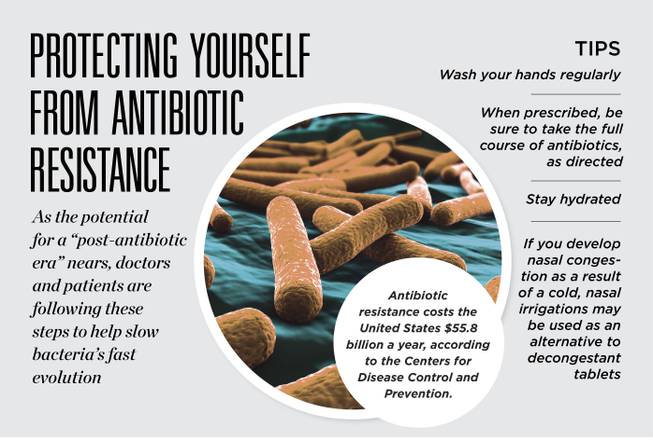
Monday, Feb. 16, 2015 | 10:52 a.m.
Antibiotic resistance occurs when an antibiotic becomes increasingly less effective at fighting the bacterial infection it once was able to defend against.
This happens naturally as part of a bacteria’s evolutionary process, but the imprudent use of antibiotics has accelerated that process. The World Health Organization has expressed alarm that we may be heading toward a post-antibiotic era and that the bacterial infections we’ve been able to successfully treat for generations no longer will respond to antibiotics.
“What that means for patients, if we don’t properly manage antibiotic resistance, is very limited and very expensive treatment options,” said Daniel Kim, director of pharmacy services at Southern Hills Hospital & Medical Center. “Improper usage patterns drive the development of antibiotic resistance; we’re seeing antibiotics being prescribed incorrectly by physicians, and we’re seeing antibiotics being taken incorrectly by patients.”
Since the 1950’s, there has been misjudgement about antibiotic use, and the fallout that we are facing because of it requires the concentrated attention of healthcare workers, policymakers and the community at large. The good news is that, as with most widespread problems, the solution starts on the ground floor: the physician and the patient.
How doctors are trying to prevent antibiotic resistance
“There was a time when prescribing antibiotics more freely was the appropriate response of physicians, but now, as we have identified the problem with the growing antibiotic resistance, the approach has had to change,” Kim said. “Many physicians are taking a more aggressive approach toward the appropriate use of antibiotics.”
That aggressive approach often employs a coordinated effort across the medical chain. “The first thing we can do is be mindful that the infection we are treating is a confirmed bacteria, and then we discuss it from a team approach, which means involving the doctor, the pharmacist and the nurses,” Kim said. “In our hospital, we also have an infection prevention coordinator, so we include them as well in the multidisciplinary team.”
How patients can prevent antibiotic resistance
“We’re seeing a lot of patients who either take antibiotics when they don’t need them, or they need them but they don’t take them as directed,” Kim said.
A common way patients misuse antibiotics is taking leftover pills from another infection.
“As a pharmacist, the most important things to communicate to patients is how many tablets to take at once, how often you need to take them and how many days you need to take them for,” Kim said. “A common practice we see is when patients stop taking their antibiotics midway through the course, once they start feeling better. The danger in that approach is, while it kills some of the bacteria, other bacteria are only weakened because you haven’t finished the full course, so those bacteria will go on to regenerate, and often they’ll have different genetic material that will be resistant to those antibiotics.”
On a patient-by-patient basis, it’s is a small change, but when you consider the millions of antibiotic courses prescribed over a year, there can be an accumulative change in bacterial groups. Because of this snowball effect, antibiotics every year develop more resistance.
Tips for protecting yourself
• Wash your hands regularly.
• Stay hydrated.
• When prescribed, be sure to take the full course of antibiotics, as directed.
• If you develop nasal congestion as a result of a cold, nasal irrigations may be used as an alternative to decongestant tablets.
How medical professionals track bacteria’s evolution
Physicians and pharmacists use an antibiogram, a historical record that catalogs the sensitivities of a specific type of bacteria to a specific antibiotic, to help ensure the correct class of antibiotic is prescribed.
“Antibiograms give the physician a road map into what they should be using for a specific infection,” Daniel Kim said. “The Southern Nevada Health District puts out an antibiogram for the entire county, and in addition, every hospital has its own individualized antibiogram.”
The physician’s goal is to prescribe antibiotics as prudently as possible and to make sure the antibiotic, once prescribed, eradicates the bacteria swiftly and effectively.

Join the Discussion:
Check this out for a full explanation of our conversion to the LiveFyre commenting system and instructions on how to sign up for an account.
Full comments policy